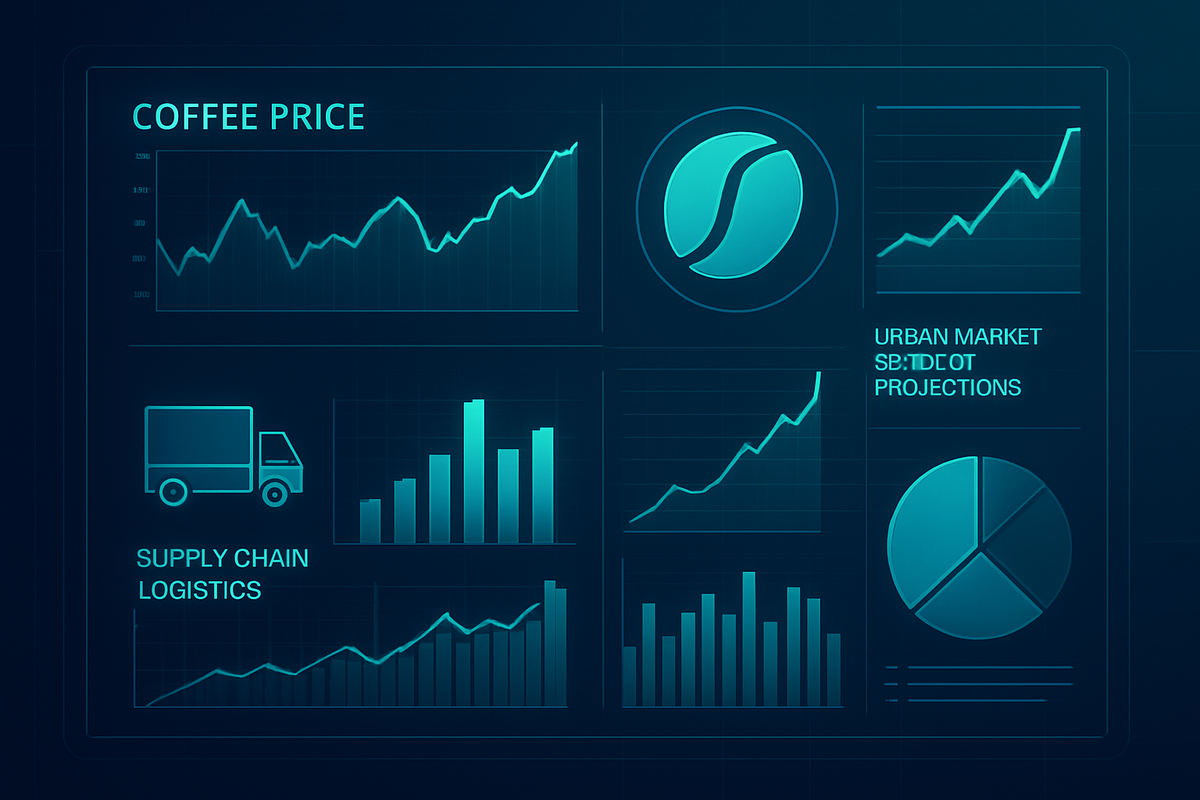
New AI-Powered System Promises Data-Driven Expansion Amidst Market Volatility
Analytics firm Coffee Navigator has today, October 24, 2025, announced the launch of a groundbreaking Artificial Intelligence (AI) tool designed to forecast growth trends within urban coffee markets. This innovative system is poised to transform how businesses approach market entry and expansion, offering data-driven insights to navigate the complexities of the global coffee industry. The introduction of such a sophisticated predictive tool marks a significant stride in the broader trend of leveraging AI for economic data analysis in specific commodity markets, promising a future where strategic decisions are rooted in advanced analytics rather than intuition.
The immediate implications of Coffee Navigator's AI tool are substantial. It aims to empower coffee chains, investment funds, and equipment suppliers to pinpoint optimal locations for new ventures, thereby reducing financial risks associated with poor site selection and uncovering previously overlooked growth opportunities. In a coffee market characterized by historical highs and volatility, such a precise forecasting capability becomes an invaluable asset for mitigating risks and making sound investment decisions. This development not only enhances competitiveness for early adopters but also signifies a notable step in the ongoing digitization and adoption of advanced analytics across the coffee value chain.
Unpacking Coffee Navigator's Predictive Power
Coffee Navigator's AI tool is a sophisticated predictive system that meticulously analyzes hundreds of urban markets to identify areas ripe for growth, particularly those not yet saturated by competitors. Its core objective is to replace speculative market expansion with a more precise, data-backed methodology. The machine learning model at its heart processes a vast array of data points, including intricate economic indicators, dynamic demographic shifts, and comprehensive commercial real estate information. This analysis culminates in the generation of "Market Potential Scores" for various metropolitan areas, complete with robust growth projections spanning 18 and 36 months, providing subscribers with detailed, data-underpinned forecasts.
While the official announcement of this cutting-edge AI tool was made today, October 24, 2025, its full commercial availability is anticipated for the second half of 2026. Prior to this, a beta version is slated for release to a select group of partners in the first quarter of 2026. The primary entity driving this innovation is Coffee Navigator, with founder Sergey Baburov identified as a key figure in the tool's conceptualization and launch. The service is meticulously tailored for a range of industry stakeholders, including significant investment funds, expansive coffee chains, and specialized equipment suppliers, all seeking to optimize their growth strategies through superior data insights.
As of its announcement, widespread independent reviews or performance analyses are not yet available, given the phased rollout timeline. However, the broader coffee industry has been keenly observing AI's potential. Baburov himself has contributed to discussions on general AI trends in the coffee sector for 2025, highlighting areas like predictive demand forecasting and automated quality control. This indicates an industry-wide recognition of AI's transformative impact, even as the market awaits specific feedback on Coffee Navigator's particular AI tool. This launch sets a new benchmark for market analysis, moving beyond traditional intuition to a more scientific and predictive approach for growth and expansion.
The Shifting Sands: Who Wins and Who Loses?
The introduction of Coffee Navigator's AI tool is set to redraw the competitive landscape of the coffee industry, creating distinct winners and losers. Major coffee producers and roasters, such as Nestlé (SWX: NESN), JDE Peet's (AMS: JDEP), and Starbucks (NASDAQ: SBUX), stand to gain significantly. These giants can leverage the AI's precise forecasts for optimized supply chain management, inventory control, and strategic sourcing. By accurately predicting demand, they can reduce waste, manage logistics more efficiently, and mitigate risks associated with supply disruptions and price volatility. AI's ability to track quality and analyze consumer preferences will also enable them to develop new products and tailor offerings more effectively, bolstering their market position and sustainability efforts.
Large coffee traders, including Volcafe, Neumann Kaffee Gruppe, and Olam (SGX: O32), are also poised to be major beneficiaries. The Coffee Navigator tool provides superior data-driven predictive analytics, enabling them to identify patterns, forecast price movements, and execute faster, more accurate buying and selling decisions. This grants them a significant competitive edge in arbitrage and hedging strategies. The technology provider itself, Coffee Navigator, will naturally be a primary winner, establishing its dominance as a key information and technology provider in the coffee commodity space and spurring further innovation in AI applications for agriculture. Early adopters with robust data infrastructure will also gain a substantial advantage by quickly integrating these insights into their operations.
Conversely, traditional analytics and market research firms relying on slower, less precise, or manually intensive methodologies face significant disruption. Their business models could become obsolete unless they rapidly integrate AI into their own offerings or pivot to specialized consulting services. Smallholder coffee farmers are also at risk of being marginalized. Lacking the capital, infrastructure, and technical expertise to access and interpret advanced AI tools, they may find it harder to compete globally or negotiate fair prices, exacerbating existing inequalities. Similarly, smaller coffee traders and roasters without access to such sophisticated forecasting will struggle to compete on pricing, inventory management, and risk mitigation against their larger, AI-enabled counterparts. Speculators relying on less sophisticated information may also find their edge diminished in an increasingly efficient, AI-driven market.
A Wider Lens: AI's March Across Commodity Markets
Coffee Navigator's AI tool launch is a microcosm of a much larger and rapidly accelerating trend: the pervasive integration of artificial intelligence into commodity market analysis. As of late 2025, the global coffee market is grappling with profound volatility, record-high Arabica futures prices, supply shortages, and extreme weather events. In this turbulent environment, an AI-powered predictive tool is not just an advantage, but a crucial necessity, offering precise insights into demand, inventory optimization, and waste minimization. This data-driven approach allows for more targeted interventions and strategic planning in a sector increasingly vulnerable to climate variability and food security concerns.
The broader "AI in coffee production" market is projected to surge from USD 324.88 million in 2025 to over USD 1.4 billion by 2034, driven by AI's role in precision farming, automated quality control, and supply chain optimization. The "AI in Commodity Trading" market is even more expansive, expected to reach USD 24.25 billion by 2033. This trend is evident in AI's applications across various commodities: from AI-powered sensors and drones optimizing crop health and water usage in agriculture, to its use in price forecasting, risk management, and algorithmic trading across diverse commodity classes. Even major financial institutions like S&P Global (NYSE: SPGI) are integrating AI into their offerings, launching AI-enhanced sector rotation indices, signaling AI's transition from niche applications to a foundational role in market intelligence.
The ripple effects of Coffee Navigator's innovation will be felt across the industry. Competitors will be compelled to accelerate their own AI development, potentially leading to increased investment in AI R&D or strategic acquisitions. For partners—growers, cooperatives, processors, and trading houses—more accurate forecasts mean optimized inventory, improved pricing strategies, and enhanced supply chain resilience against climate and geopolitical disruptions. However, this rapid AI integration also raises regulatory concerns. While specific new AI regulations are pending, U.S. financial regulators emphasize responsible AI use within existing frameworks, particularly regarding "herding risk" where concentrated reliance on similar AI models could amplify market movements. Data quality, cybersecurity, and third-party risk management also emerge as critical policy considerations. Historically, the current AI boom draws parallels to the dot-com bubble, with concerns about asset price corrections, even as AI's demand for commodities like copper and uranium echoes past technological revolutions that reshaped raw material demand.
The Road Ahead: Navigating an AI-Driven Future
In the short term, Coffee Navigator's announcement will intensify competitive pressure, spurring heightened awareness among coffee chains and investors about AI's strategic potential. Early adopters gaining access to the beta version in Q1 2026 will secure an initial advantage, refining their market entry and expansion strategies with data-driven insights. This period will also see increased scrutiny of the tool's accuracy and reliability, influencing its broader market acceptance. Internally, major coffee corporations and financial institutions will likely initiate discussions on integrating similar predictive analytics, moving away from traditional, intuition-based approaches.
Looking further ahead, post-full commercial launch in H2 2026, widespread adoption could lead to significantly optimized market penetration for coffee businesses, potentially reducing the failure rate of new locations and enhancing resource allocation. Investment funds are likely to increasingly leverage AI insights for guiding investments in coffee-related ventures and commercial real estate. The tool itself may evolve to include more granular data and real-time adjustments, fostering a more sophisticated and diverse AI forecasting market. While Coffee Navigator's focus is retail demand, its success could indirectly influence demand for green coffee beans, impacting commodity traders and producers who will also need to adopt broader AI forecasting for commodity prices, considering weather, geopolitics, and logistics.
Strategic pivots are paramount for industry players. Coffee chains and retailers must shift towards AI-powered location scouting and expansion planning, integrating these insights into real estate, marketing, and operations. Investment funds will enhance due diligence with AI-generated reports, while equipment suppliers can target sales based on predicted growth markets. Coffee producers and traders, though not directly using Coffee Navigator's retail tool, must integrate downstream demand signals into their supply planning and embrace AI for broader commodity price prediction. Smaller businesses face the challenge of accessing affordable AI solutions or specializing in unique niche markets to avoid being outmaneuvered. Market opportunities include improved ROI, reduced risk, optimized supply chains, and the identification of underserved markets. Challenges encompass data quality and bias, the high cost of adoption, technological literacy gaps, and the "black box" problem of AI, along with the inherent volatility of commodity markets.
Final Brew: AI's Lasting Impact on Coffee and Commodities
The launch of Coffee Navigator's AI tool is more than just a product release; it's a potent symbol of the ongoing paradigm shift in how the coffee industry, and indeed all commodity markets, will operate. The key takeaway is clear: data-driven decision-making, powered by advanced AI, is rapidly becoming indispensable for competitive advantage. This tool aims to empower businesses to make strategic, analytically sound choices regarding market entry and expansion, moving beyond traditional methods.
Moving forward, the market will become increasingly efficient and competitive, with AI acting as a critical differentiator. The lasting impact will be a more optimized coffee value chain, where precision forecasting minimizes waste, enhances profitability, and allows for agile responses to market dynamics. This specific development also underscores the broader and profound influence of AI across all commodity markets, from optimizing logistics and quality control to transforming trading strategies and influencing the demand for hard commodities like copper, driven by AI's massive infrastructural needs.
Investors in commodity markets, particularly those with exposure to coffee, should closely monitor several key indicators in the coming months. Firstly, the performance and adoption rates of Coffee Navigator's AI tool, especially its beta in Q1 2026 and full commercial launch in H2 2026, will be crucial. Secondly, observe the broader integration of AI across the coffee industry, including its impact on pricing, logistics, and supply chain management. Thirdly, watch for potential shifts in commodity price volatility and how AI-influenced sentiment interacts with traditional supply-and-demand fundamentals. The "AI arms race" is significantly driving demand for hard commodities, and investors should consider these ripple effects. Finally, the evolution of regulatory frameworks around AI, particularly concerning market stability and data integrity, will be critical to watch. The Coffee Navigator AI tool is a tangible manifestation of AI's pervasive influence, signaling a future where strategic foresight, powered by intelligent systems, will be the ultimate market mover.
This content is intended for informational purposes only and is not financial advice





